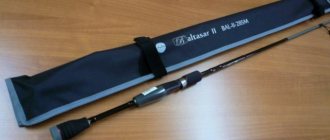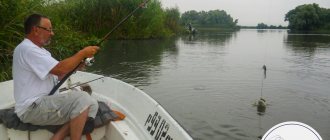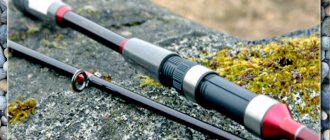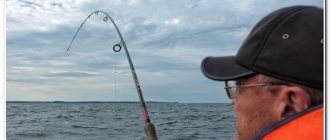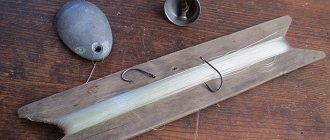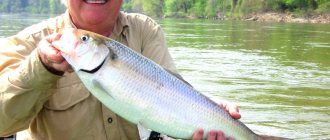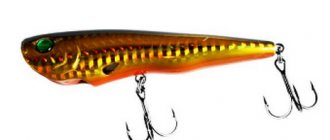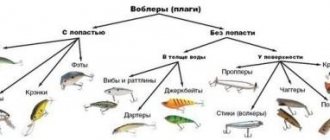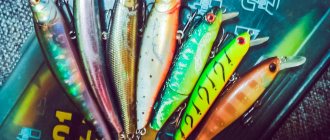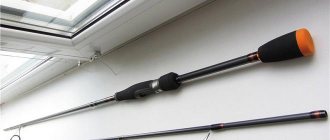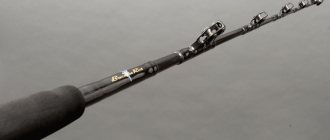Float tackle for pike does not lose its relevance, despite the strong pressure from spinning fishing with many effective artificial baits. This type of fishing attracts pike fishers with its simplicity in organizing the process and the low cost of collecting gear. But the catches themselves are comparable in effectiveness to spinning hunting, and sometimes can even exceed this popular direction.
You can catch pike with a float rod in any type of reservoir, regardless of the strength of the current, the degree of algae overgrowth, depth and current weather conditions. With a float you can hunt pike throughout the open water season. These factors make this type of fishing accessible to a wide range of fishing enthusiasts; fortunately, the natural resources of reservoirs make it possible to catch pike everywhere.
To achieve success in catching a trophy, the fisherman needs to familiarize himself with the equipment for fishing and the options for preparing rigs, know how to choose the right bait and determine the place to hunt for the predator. You can become familiar with all these nuances of the process of catching pike on a float by reading this article, and use the information received in practice by selecting a suitable body of water for hunting.
What to catch
Catching pike with a float will require the selection of powerful gear that can withstand the resistance of large fish that struggle quite strongly when caught. As a rule, the installations themselves do not require a thin and miniature design and can be rough and not particularly sensitive in nature. In pike fishing, the reliability of equipment comes to the fore. It is this criterion that fishermen pay the main attention to when equipping a pike float rod. We will discuss the main elements for assembling this type of fishing rod in continuation of the material presented below.
Rod
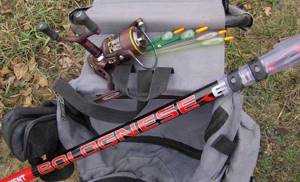
As a live bait float rod, it is better to give preference to Bolognese tackle, with reinforced guide rings and a high test value, which is in the range of 50–70 grams. The length of the rod varies from four to seven meters, which depends on the fishing distance. The universal telescopic blank with medium action covers any fishing conditions. Fishing for pike with a float rod falls into the category of dynamic, requiring frequent recasts, and the rod should be selected from the lightest materials, which directly relates to carbon fiber and combined carbon fiber options. Particular attention is paid to the device for attaching the coil, which in the best offer looks assembled from metal components that form the mounting structure.
Catching predators with a float rod
Date: June 3, 2012 | 728
I prefer to catch predators using spinning rods and artificial bait. I love spinning for its sportiness, fishing activity, and the absence of the need to search for and get bait (which is often not easy). However, there are other, no less interesting and exciting ways to catch pike, perch, chub, catfish and other predatory fish in our waters. One of them is catching a predator on a float rod with a bait bait , small fish.
Catching a predator with live bait using a float rod is carried out either in still water or in sections of rivers with a slow flow. On rapids, a spinning rod, or, in extreme cases, a donk, is much more effective.
They fish with a float rod using live bait mainly from the shore. I believe that if you have a boat, again, it is more efficient to use a spinning rod, because... It is possible to fish the maximum water area of the reservoir and place the bait at different angles.
If there is a clear “trump” area where there is a high probability of a predator biting , then you can place 2-4 fishing rods, at a distance, but in such a way as to control them all. Well, don’t forget to secure the rods well and loosen the reel clutches. Otherwise, if the fisherman does not react or bites on several fishing rods at once (and this has happened...), a large predator can easily steal the tackle.
If there is an active search for fish , with constant movements from place to place along the reservoir, then one lightweight live bait fishing rod .
So, the gear itself is for catching a predator with live bait with a float . You need a strong, telescopic rod, 4-5m long. A shorter one will make it difficult to cast far, and a longer one will be heavy and more difficult to maneuver when biting fish. The rod must have guides and a reel seat.
reel is needed (depending on who you are hunting). It is preferable to use spinning reels number 2000-3000, with monofilament winding with a diameter of 0.25-0.35mm. This option is most optimal when you plan to catch perch, medium-sized pike, pike perch, and chub. But if you are hunting for a particularly large pike or catfish, then it is better to use powerful plug rods, a baitcasting reel, and a cord instead of fishing line.
The float should be large and bright. If fishing is carried out in half the water or near the surface (for example, when fishing for chub), then a more inconspicuous float is needed. If the depth at the fishing spot exceeds 2-2.5 meters, then it is more advisable to use a sliding float . This is due to the fact that with a greater distance from the sinker to the float, with their position fixed, it is much more difficult to cast the fishing rod far and accurately.
The sinker used is oblong, spindle-shaped, sliding. A leash is a must. You can use thin leashes made from modern leash materials or thick fluorocarbon. If the likelihood of a pike biting is minimal, and you are purposefully fishing for perch or chub with live bait, then you should do without a leash or use thin fluorocarbon. The leash is equipped with one or two swivels. At the end of the tackle there is a sharp tee or a tackle for attaching live bait.
Depending on the fishing location, various small fish are used as live bait . Most often it is: crucian carp, gudgeon, roach, perch. Live bait is placed behind one of the hooks of the tee, under the back, so as not to damage the ridge. Or they use more complex tackles from several hooks. When fishing occurs on the current, you can hook live bait onto the lip.
The best places to catch predators with a float rod : windows in thickets of aquatic vegetation (pike, perch); bushes and trees hanging over the water, reverse currents, whirlpools (chub, pike, perch); pits, snags (catfish, pike, pike perch); edges along water lilies (pike, perch).
It is important to remember that you should not rush into hooking. This is not spinning for you. After the predator starts biting, it is necessary to give it a pause, time to reliably take the bait. When the bite moves into a more active phase (the float is actively moving or drowning) - you need to hook!
Share with your friends:
Category: Catching predatory fish
Tags: Live bait, Float, Float, Fishing rod, Predator
Coil
For a Bolognese fishing rod, a spinning reel is selected, which has high tractive force parameters and a multi-level clutch setting. The gear ratio of the mechanism is not the main parameter of the accessory and its value does not particularly affect fishing. The capacity of the spool is sufficiently medium-sized, which is typical for most spinning spool options. A reel in a light metal alloy body that does not rust and does not allow moisture to enter the gears of the mechanism is one of the most suitable options for a pike rod.
Leashes
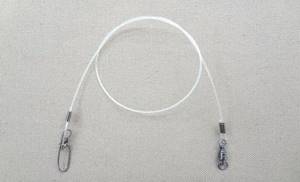
Leashes made of metal materials have long been a thing of the past, having successfully replaced equipment elements made of soft Kevlar and fluorocarbon fishing line. For float rigs, leashes in sizes from 15 to 20 centimeters are used, which is enough to successfully and quickly deliver bait to the fishing zone, and does not restrict the movements that live bait makes while in the water.
Important! The leash must be equipped with a swivel, which prevents the lines from twisting and the accessory itself from tangling.
Hooks
Since bite control is constantly under the watchful eye of the fisherman, it is advisable to use single and double hooks in rigs, the appearance of which is less alarming to the predator, and the use of such forms causes the least damage to live bait when baiting. Rigging a float rod through Kevlar leashes is most convenient through sliding doubles. With fluorocarbon leashes, single hooks with an extended shank are crocheted in numbers of 6–8 units. Hooks made of thick wires with a sharpened straight tip are used. The color of the accessory is selected in dark colors, black or brown, avoiding the possibility of distinct and garish colors in relation to the bait.
Float for pike
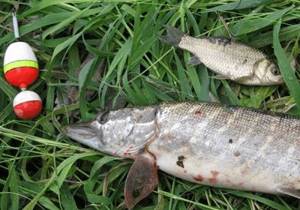
Floats are made of foam or balsa, using barrel-shaped bodies with a short antenna and keel.
Important! It is advisable to have the color of the alarm in bright red or crimson tones, which most attracts the angler’s eye when the float is on the water.
The mass of the float is selected based on the weight of the live bait with an increase in quantity to the weight of the fish of approximately 5–7 grams. A pike float fishing rod is rarely equipped with floats that exceed a mass of 20 grams. A practical option is to use a sliding type of float, which covers fishing conditions at different depths without reconfiguring the main parameters of the equipment.
Read here about attaching the float using various methods.
Sinker
Convenient, efficient and reliable in installations is the use of a sliding single sinker in the shape of an olive. The weight of the lead weight is selected based on the weight of the float with the correction of its reduction in comparison with the weight of the live bait. The movement of the load in relation to the leash is limited by installing a silicone stopper on the cord. Before mounting the olives, visually check the load for the absence of burrs, which often appear when forming a hole. If necessary, the metal warped by the puncture is cleaned off with a needle file, thereby eliminating the possibility of deformation and cutting of the fishing line in the place of loading.
Installation of gear
Installation begins with installing the selected reel into the mount, which is pressed tightly, without play or shackle, onto the rod blank with the mounts. After installing the spinning gear, a piece of monofilament is wound onto the spool. To ensure a reserve, the cord is wound in a section of at least 50 meters, winding under load and ensuring that the turns of the material are evenly and consistently laid out. After winding, the line is passed through the winding rings and a sliding float is mounted on the cord, after which a sinker is threaded onto the line and a stopper or buffer bead is placed to prevent the knot that secures the leash from breaking.
After tying the leash to the fishing line, the hook required for the equipment conditions is mounted through the swivel. After this operation, you can confidently begin to catch pike with a float.
How to choose a scale
The structure of a spinning rod is a characteristic that determines whether it will be convenient to cast bait and land fish. This is essentially the angle of the blank with a load, and manufacturers mark their rods with both test and action.
Classification of spinning rods by structure:
- very fast (extra fast);
- fast;
- average (moderate);
- slow
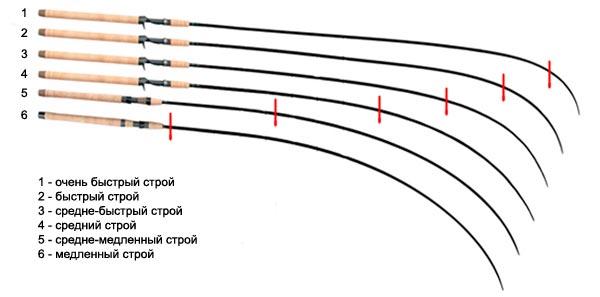
The rod has a very fast action; the upper quarter of the whip bends under the weight of the bait, which is convenient for making long casts. The top third of the whip bends on a fast blank.
A medium action rod bends with its upper half under load, while a slow spinning rod bends its entire length.
Slow spinning rods “forgive” the fisherman’s mistakes when landing heavy fish, but the pleasure from the process is less than we would like. As they master spinning fishing, fishermen feel more confident when choosing an action, as they understand what it affects.
When deciding how to choose a fishing rod for a spinning rod, you must pay attention to the structure of the blank and select it for the fishing conditions.
Search Locations
It is better to select promising places for hunting for toothy fish in river backwaters and ponds with aquatic vegetation, in the middle of which there are natural clean windows and gaps that allow placing live bait.
Important! For the most part, fishing with float gear is carried out in the summer, during the season when pikes do not migrate in search of prey, but stand in their favorite places, waiting for the passage of a prey suitable for feeding.
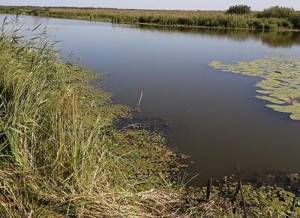
No less productive points are the boundaries of thickets with clean water, as well as the trajectories of one and a half meter indentations from the walls of reed thickets. In such conditions, you have to fish from a boat, anchor the watercraft directly from the reeds and feed live bait into the fishing zone in the direction of the wind or current. Pike can also be caught well in water areas with underwater cramps. The main condition for fishing in snags is to determine a clean bottom, which is most conveniently done by checking the bottom topography with an echo sounder.
On rivers with a current, the rigs are launched along the edges and rifts of the depths, making long runs with moments of holding live bait for short periods of time. The best results are obtained by morning fishing and the time just before sunset in clear and warm weather. On cloudy days, short-term bursts of bite are possible during the lunch period. The predator also becomes active before an approaching thunderstorm, which the angler must take into account when planning pike float fishing strategies.
Fishing rod for pike in winter
Winter fishing rods for pike are powerful, elastic and strong. Of course, you can pull out a toothy one with a weak perch fishing rod, but sooner or later a strong blow from a predator will simply break it right in the angler’s hand. For a targeted hunt for this predator, it is better to use normal fishing rods designed specifically for such fishing.

Fishing rod
To make a winter fishing rod for pike, you will need a good hard fishing rod, a reel and a fishing line of 0.2-0.4 mm. The equipment is adjusted depending on how the equipment is used. If the whip is very soft, then during hooking you can simply not break through the hard mouth of the predator. Therefore, a strong rod is chosen, at least 30 centimeters in length. On sale you can find ready-made winter fishing rods with an inertial reel or separately. The general approach is to reduce the weight of the fishing rod whenever possible, but not at the expense of strength. Showing off a heavy “club” all day is a dubious pleasure.
Some modern lures (ratlins, balancers) require a relatively sensitive tip, otherwise it will be impossible to give them the correct action. You should pay attention to the material of the handle. Ordinary plastic is cold in the cold. Handles with neoprene pads are better suited, making it comfortable to hold the fishing rod with bare hands even in cold weather. You can make a fishing rod yourself. Rigid quivertips (tops) from a summer feeder are perfect for this. Pike fishing rods can be of different calibers. It depends on the size of the intended trophy and the weight of the bait used. Perch tackle is also suitable for small-toothed fish.
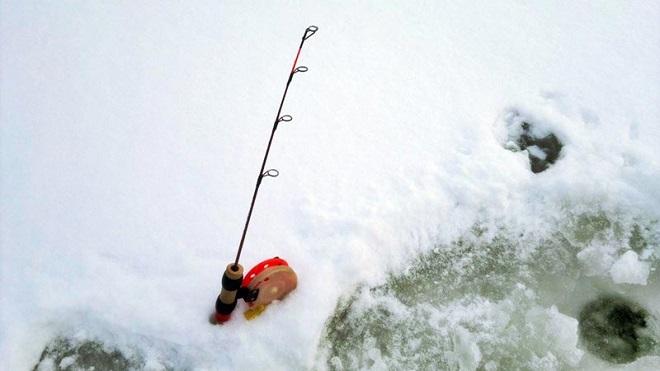
Coil
For regular fishing at shallow depths, a reel may not be required; ordinary reels will do. In its modern form, equipping a fishing rod for pike fishing in winter with a reel is a necessity. Such tackle becomes universal, it is convenient to use at various depths, and the jerks of trophy specimens after a bite can be worked out with a friction brake (if equipped). Most anglers use ordinary plastic reels for winter lures. It is better to choose reels with a large drum - at least 50 mm in diameter. The best option is special inertial reels for winter trolling with an open drum and a friction brake. When hunting trophy specimens, this is an essential part of the equipment. Some hobbyists use spinning reels (spool size 1000-2000). Convenient, but such a reel requires constant care and anti-freeze lubricant.
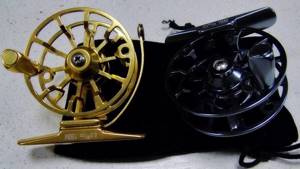
Nod
On the issue of the need for a nod in a pike rig, the opinions of anglers are divided. Some use it, others don't. If you have a high-quality fishing rod with a sensitive tip, the use of a guard is not necessary. If the tackle is oak, then it is better to put a nod. Sometimes, during periods of passivity, even a pike can peck carefully, “on the rise.” A pike guard is used on winter bottoms, as well as when trolling. The lure guard should not make parasitic vibrations when playing with bait. The best thing is a silicone “snot” tube, which bends almost completely under the weight of the bait. For donks, metal or spring alarms are suitable that can withstand the current, with bright balls at the end for visually recording a bite from afar.
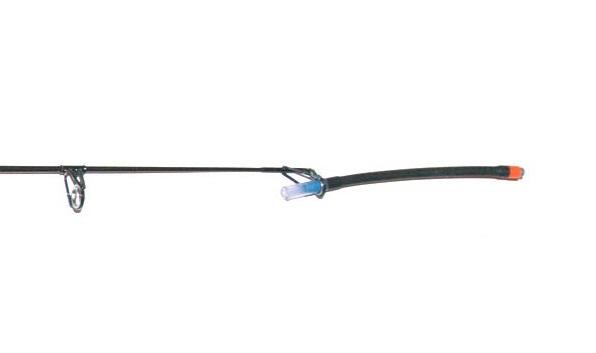
Equipment
When rigging a winter fishing rod for pike, a fairly thick and strong fishing line is used. The fishing line for pike is chosen to be of high quality, rigid, without memory. A soft fishing line is not suitable for winter fishing for pike - it will stretch when hooked, which can lead to fish loss, especially when fishing at depths of 5 meters or more. Winter toothy hunters usually do not use cord or braid. Braid freezes when wet, and in severe frost it is simply impossible to fish with it. Therefore, a regular monofilament with low elongation is used, or better yet, a special winter fluorocarbon. The diameter of the fishing line used varies from 0.2 to 0.4 mm. More often it is still 0.3-0.35 mm. This thickness is sufficient for almost any conditions. When hunting for small pike with small baits, a thinner thread is used, and when fishing for trophy specimens or in snags, a more powerful one is used.
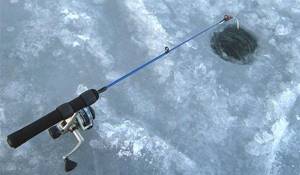
In any case, the tackle must be strong and reliable. When fishing for active fish (on first ice, in February and March), a leash is required. Otherwise, the toothy one will simply cut off your bait. The leash used for pike in winter is the same as in summer. Any industrial leashes used in summer on spinning rods, with a swivel on one side and a fastener on the other side, are suitable for the equipment. Due to the dead winter, in clear water the predator may not take it when using a metal leash. It is also harmful for the game of balancer and ratlin. Therefore, the leash is not always used. At the same time, the threat of losing the bait increases. Fluorocarbon leader line is a great alternative.
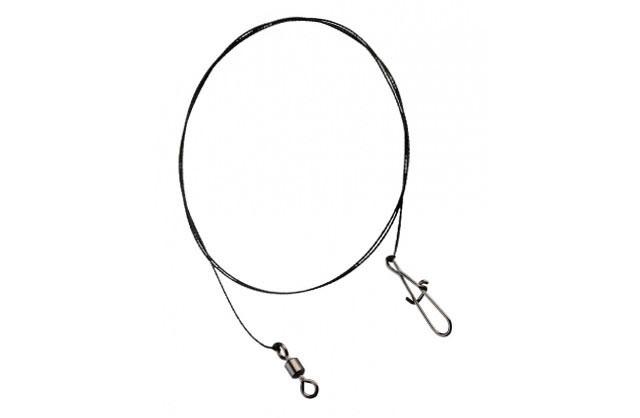
Tungsten
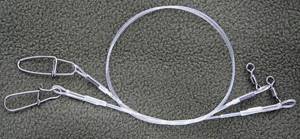
Transparent leaders made of thick fluorocarbon

Donka for live bait
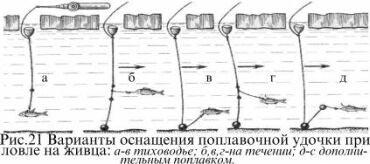
Winter float for live bait
Tackles
To catch pike in winter using dead fish, special tackles are used. Tackles for catching pike in winter can have different configurations, depending on the depth, strength of the current and the size of the bait used. This is all selected individually directly on the pond.
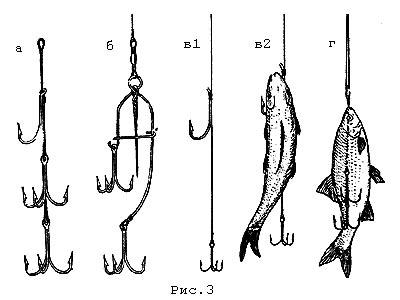
Choice of live bait and bait
In principle, pikes feed on various living creatures that come in accidentally and live permanently in the reservoir. Any fish that is only a third smaller in size than the predator can certainly become a potential victim. Waterfowl chicks, small rodents and amphibians will fit into the toothy diet, regardless of the season. For the angler, the best option would be to select fish fry as bait, which lives in abundance in the fished reservoir. Predatory fish are accustomed to such food and live baits, after being attached to hooks, do not arouse suspicion among pikes and are easily attacked by fish when they enter their field of vision. Based on these considerations, we can conclude that when going pike fishing, a fisherman should familiarize himself with the inhabitants of the reservoir and determine the main food item of the predator in order to use it as bait.
Important! Live bait can be caught directly on the reservoir, using a small float rod with bread crumbs or maggots on a hook, or using a lift, which is used to catch fry in the shallows and boundaries of clear water and shallow underwater vegetation.
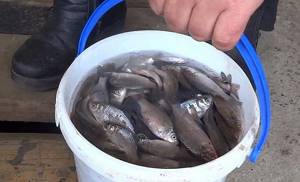
The most common, easy to catch, and hardy bait material is small silver carp . The second most popular species in pike fishing is the small gudgeon. This fish is also hardy, but even when catching it, it will require the fisherman to have great skills in finding parking spots and fishing itself. Suitable for live bait and roach, perch, bleak, carp and even white bream. The listed fish species are not as hardy as crucian carp and gudgeon, but they are no less successful in pike hunts.
Methods for attaching live bait vary depending on the type of hook used in the equipment. Single hooks more reliably attach the fry to the back, which is pierced under the upper fin, trying not to touch the baitfish’s spine, which can immobilize the bait. In some conditions, baiting fry by the lip brings more bites; apparently, this depends on the change in the position of the fish’s body in the water and its unnatural movements. Using double expandable hooks, a more optimal way to attach live bait is through the gills. This type of installation completely eliminates the removal of the bait when casting, does not greatly affect the activity of the placed fish and minimally injures its body. When using a tee, the fish are attached, as in the case of a single hook, under the dorsal fin.
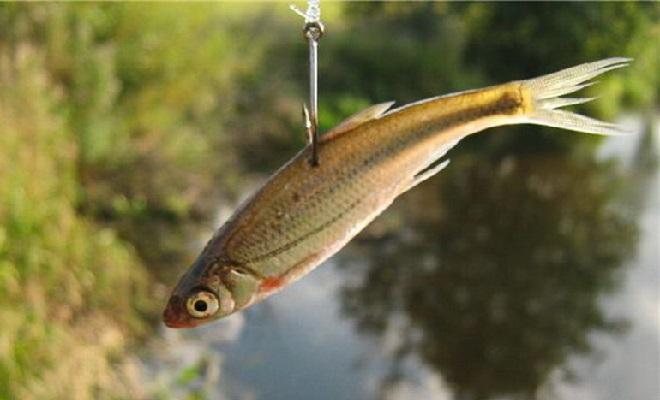
Under certain conditions, the fry can be pierced by the tail with one of the three hooks of the tee, thereby positioning the fish under water with its head towards the bottom, which for the predator means weakening of the prey and instills in the toothy hope for the availability of food and the complete absence of a fight. The main criterion for attaching live bait with any method of attachment is the absence of the possibility of the bait coming off when casting, because it is at the moment of submitting the rig to the fishing zone that the live bait experiences stress from hitting the water and can fly off the hook if the attachment is incorrect.
Live bait
The most durable fish are rotans and crucian carp, but pike and perch prefer local fish - bleak and verkhovok. In large pools without a current, they are hooked under the dorsal fin, and in a current - by the lip, otherwise the baitfish will spin like a propeller and tangle the line.
For fishing in currents, it is better to use a hook with one shank. Doubles and trebles will be unnecessarily bulky when piercing the lip of a baitfish. But in deep, calm water they work more reliably and efficiently. Therefore, the fisherman needs to have leashes with various hooks in stock.
I recommend to read:
Carp and live bait donkey
Share with your friends!
Catching pike with a float
You can catch a pike with a float rod using several strategies, in which the angler also uses a certain fishing technique. A more classic method includes hunting using the so-called ambush method, when the angler, having decided on a promising point, sets the bait for a long cast, lasting up to several hours. During the entire period of fishing, you need to monitor the condition of the float and hook a predator when biting.
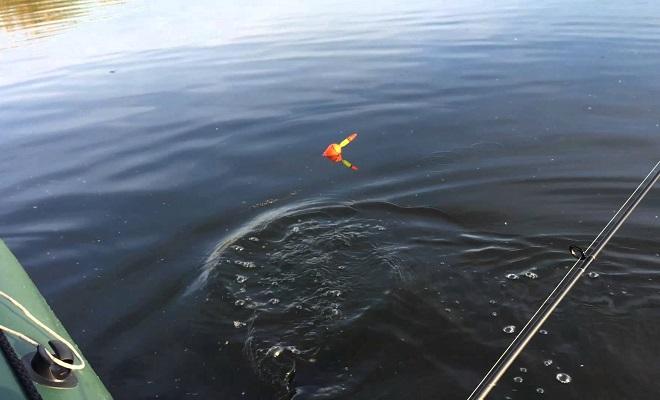
The second method of pike hunting is carried out dynamically, when the angler constantly changes his location moving along the shore or walking on the water in a boat along promising places, briefly delivering live bait to certain points. This kind of fishing is practiced in reservoirs that are heavily overgrown with algae, where live bait is placed in clean windows among the grass. The strategy itself develops according to the following scenario - the angler approaches the gap between the vegetation that is accessible by casting distance and serves the fish, waiting for a bite for 2-5 minutes. If during the time period presented above the predator does not attack the bait, the pike goes to the next gap and repeats the operation. Having previously determined the trajectory of movement and approaching the final fishing point, the fisherman returns to the first point and begins the cycle in a new circle. The entire fishing cycle should take about 1.5-2 hours. In windows where exits and bites were observed, it is recommended to make stops longer than five minutes, increasing the time to 10–12.
Now let’s present a direct algorithm for fishing equipment with a description of the actions of the fisherman. Fishing begins with casting the tackle, doing this manipulation with caution, trying not to hit the bait on the water and not make noise with the tackle and equipment falling into the water. After casting, the float is allowed to calm down and wait for the predator to emerge. Often, already in the first minutes, pike standing nearby attack the fry, which you need to be prepared for, regardless of the short period of time. In a calm state, the float should barely noticeably tremble from the play and movements of the bait, which indicates its activity, and therefore its attractiveness to fish. The pike bite itself occurs in two stages. The first stage is the capture of the victim, which can be seen from the float by the sharp withdrawal of the accessory to the side, followed by a stop. The moment of stopping indicates that the predator has taken the bait and, having stopped, begins to swallow it. The pause can last several minutes, after which the float again begins to move towards the shelter or goes to the bottom.
The second stage of the signaling device's movement indicates that the moment of cutting has arrived. This is what you need to do by sharply pulling the rod in the opposite direction of the movement of the float. The caught pike begins to show strong resistance, trying to go into the thickets, which it should not be allowed to do under any circumstances, holding the line in constant tension, lifting the rod up and pulling the trophy to the shore or boat. Having pulled the caught fish to the shore or boat, they begin to place it in a landing net, after which they take it ashore and put it on a kukan, releasing it into the coastal zone or attaching it to a carabiner on the boat.
Important! It is worth noting that when fishing for pike, you must have a yawner and pliers. These tools help to quickly and safely remove hooks from the toothy mouth without injuring not only the fish, but also the fisherman.
Catching predatory fish with a float
This was in August. Early in the morning I caught tench. Before it got hot, I wanted to fish for perch and zander for another hour. Typically, the 4g Waggler was replaced with a large, double-capacity sliding float for this purpose. But since I intended to fish with small dead fish and was also somewhat lazy, I simply left thin floats on the line. I tied hook No. 6 and caught several small roach no longer than my little finger. I set the depth of descent so that the lowest pellet lay at the bottom.
When bitten, the float would rise out of the water. My fishing spot was above a small perch hill, 20 m from the shore. It was necessary to fix the bait in that place; there was dead water to the left and right of it. With a regular large float it was difficult to keep the bait in place. I had to clamp all the large pellets on a leash and lower them to the bottom so that the float would not be blown away by the wind. Such rough fishing meant that although many walleyes would sink their fangs into the bait, they would immediately abandon it. Obviously, the resistance of the submerged float was too great for them. I cast the first rig, lower the rod tip into the water and tighten the line to reduce the impact of the wind. The Waggler float has only one eye at the bottom end, so the line holds well underwater. I place the rod horizontally on the stand. The wind does not affect the float, the bait remains in place. Two red antenna tips peek out of the water above the “perch hill”.
Read: Pinwheels and diverting leash: gear for catching perch in early spring
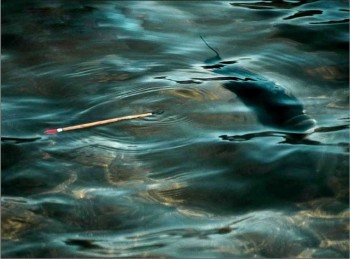
I've been waiting for half an hour. Then one of the antennas, as if under the influence of an invisible hand, protrudes from under the water. She dances, dives and finally walks away. My rod whistles up and the hook is successful. A lightweight match rod bends a lot. A fishing line with a diameter of 0.22 mm rings in the wind. True, it was not a giant that was caught, but the predator fought well on thin tackle. Every time he made a jerk to the bottom, I clearly felt it with my hand. Ultimately, I brought a 62 cm long pike perch into the net. The thin tackle turned fishing into an unforgettable event.
That day I saw the red tip of the antenna rising out of the water several times. The next bite brought a beautiful perch. Obviously, this was the school’s “taster”, since two more fish followed it. It is noteworthy that each bite ended in the capture of fish. With coarser tackle and regular floats, I often had unsuccessful bites. Sometimes it didn’t even get to the point of hooking, because the fish simply threw the bait.
Thin float fishing for predatory fish is quite possible, over time I became convinced of this. For catching perch and pike perch, I probably don’t know the best method. Even for night eel fishing in clear areas, I use a Waggler with a firefly. Like pike perch, eel rarely bites with a rapid strike. He often plays with the bait for a long time before finally dragging it away. How would the careful bites of predators with rough float equipment occur? Would they even be noticed?
Often the bait is torn off or has marks of the teeth of a predator on it, and the angler did not see any movement of the float. In any case, I have significantly increased the associated zander catches when night eel fishing by using lightweight Waggler floats.
Read: Methods of attaching fishing line to a fly rod
What about pike fishing? Are floats with a thick round body and a load capacity of 30 to 40 g appropriate here? No! These crude floats were really necessary when it came to keeping 20 cm long bait fish from diving into the depths with the float. But since dead fish don't tend to dive, I may want to skip the heavy-duty floats.
Catching predatory fish with the sensitive Waggler float is so much fun because you can accurately monitor the bite. An experienced fisherman knows even before hooking which fish are interested in the bait.
Here are typical bites
Sudak . Often pike perch bite like bream: Waggler rises out of the water, sometimes even lies down. Active fish immediately drag the float to the side, but rather slowly. The more indecisive ones let the float capsize several times before walking away.
Perch . Quick bite. Waggler jerks down or to the side. Then it freezes for a short time and quickly goes into the distance. Large fish show a real sprint after biting.
Eel . Waggler trembles and sometimes lies down. Small fish can play with a bait fish for a long time, while large ones sometimes quickly drag it away. If a float moves quickly along the surface of the water, it can be seen that it moves in smooth zigzags.
Pike . The Waggler dives underwater, appears briefly on the surface again, and then quickly darts away. Sometimes the pike will travel 20m before stopping briefly to turn over the bait. Then he takes off running.
Read: The most catchy non-standard lures for pike fishing
When catching pike with a dead fish, the float must meet, basically, two criteria:
• provide as little resistance as possible when biting; • be clearly visible to the fisherman both at long distances and in high waves.
A successful float model for pike fishing is the Drennan Loafer with a carrying capacity of 7.6 g. I can see its red antenna even in windy weather at a great distance. Most often, I set the working descent of the float slightly greater than the depth at the fishing point, so that the bait remains on the bottom. Only for fishing with free drift of equipment, I prefer standard floats with a more massive body and increased carrying capacity.
Firstly, they have greater windage, which may be advisable for exploratory fishing. And secondly, I need more weight to keep the bait at depth. In other cases, the Waggler is a catchy alternative for pike fishing, especially in those reservoirs where the fish are shy and have already suffered from fishing. But I do not advise you to use a match rod if you expect to catch large pikes or if the reservoir is replete with snags and algae. In this case, I take a light carp rod and a fishing line with a diameter of 0.25 mm. This only slightly reduces the pleasure of fishing, but it greatly increases the chances that you will catch a pike in the landing net.
Advantages of fishing for pike with a fishing rod
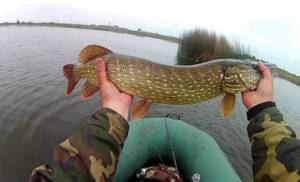
The advantages of this type of fishing include the low cost of equipment and installations, as well as the simplicity of the designs, which indicates the accessibility of fishing regardless of the configuration of the gear. In addition, the method allows you to target promising points in a targeted manner, without frightening predators with frequent casts, and the consequences of such caution are successful catches, where large specimens of pike are by no means a rarity, but a regularity. Using a type of bait that is familiar to a predator also increases the chances of a good catch, and the bait itself is obtained without any particular difficulties and for the fisherman catching it right on the pond has no price. All of the above advantages clearly indicate the further development and improvement of float pike fishing and its popularity is unlikely to decline in the future, attracting more and more anglers into its ranks.
Tackle for predatory fish
How many people dream of spending a weekend with a fishing rod near a pond, because communication with nature always has a beneficial effect on their internal state. And for many, fishing has become a business that helps them provide for their families. It is often not so easy to get a good trophy. This is especially true for fishing for predatory fish. There is no way to do without knowledge of what gear you will need to catch a predator.
Tackle for predatory fish
Most often, a spinning rod equipped with artificial bait is used to catch predators living in various bodies of water. Fishing is carried out by casting bait over a long distance and then reeling in the fishing line. When reeling is carried out, vibration appears in the water due to the bait. If a predator sees the bait, then, guided by a hunting or security reflex, he will grab it.
If an angler takes a spinning tackle for a predatory fish, he can perform the retrieve in different ways:
- jig;
- microjig;
- nanojig;
- twitching;
- on a spinner.
Before you go fishing, you will need to properly assemble your spinning rod. The length of the rod will depend on the conditions in which the predator is planned to be fished. If fishing will be done from the shore, then the optimal form is 3-3.5 m. If there are too many trees on the shore, then it is better to choose a rod with a length of 2.3-2.5 m.
For fishing from a boat, the length of the tackle is not particularly important, the main thing is that it is convenient to work with. It is logical that the longer the rod, the harder it is to cast. The optimal solution is to take a 1.9-2.1 meter form.
An important rule: the more the bait weighs and the larger the predator the fisherman plans to catch, the more powerful the tackle should be.
For spinning, of course, you need fishing line. In this case, it is better to refrain from monofilament. Experienced fishermen advise using braided line.
Lures can be in the form of:
- rotating and oscillating spinners;
- wobblers;
- vibrotails and silicone fish with jig heads;
- poppers;
- jerkbaits.
Asp fishing
The “river corsair,” as many fishermen call it, is usually caught using spinning tackle. Casting the bait should be carried out a little further than the area where splashes of fish are visible. In addition, fishing is allowed using bottom, wire and float rods.
If there is spring fishing ahead, the best bait for the “corsair” is a jig. It’s good to use a castmaster or devon for long distances. Surface baits are no less effective. Do not forget that the asp is a predator, and therefore he will like bait in the form of natural food.
Depending on the fishing method, you will need to stock up on:
- crushed worms;
- crayfish meat;
- butterflies;
- beetles;
- dragonflies;
- beetle larvae and so on.
There is one feature in the behavior of the asp that cannot be ignored. The predator is a rather cautious fish and boasts excellent eyesight. And when he notices the fisherman, he immediately disappears and does not return back soon.
It is better to go to the asp early in the morning or in the evening. It is necessary to camouflage yourself well so that the fish cannot see any movements.
The optimal length of spinning tackle is 3 m. Of course, you can use different rods, but a 3-meter spinning rod has important advantages:
- Ability to cast long and accurately.
- It is convenient to work with it while in tall grass.
- It is much easier for them to catch a large specimen.
As for the disadvantages, this is probably the only one: the tackle is heavy, so considerable effort will be required when casting.
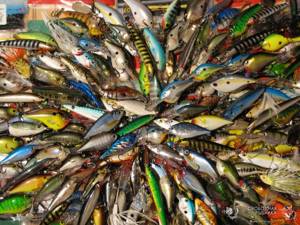
Perch fishing
You can catch the predator almost all year round, but it bites most actively at the end of spawning, that is, in the last days of May and early June. Perch is voracious. When he is hungry, he tries to find prey as quickly as possible, and when he catches it, he catches it in his mouth and squeezes it, and only then swallows it. Suitable gear for perch:
- float and bottom fishing rods;
- spinning rods;
- mugs;
- summer girders;
- fishing rods with short rods (for winter fishing).
The predator is lured with worms, bloodworms, small spoons, and jigs.
For small fish, lightweight equipment with a line having a thickness of 0.25-0.3 mm is suitable, and if the perch is large, spinning tackle is useful for catching predatory fish with small spoons. The fish will only chase after the big ones, and then turn around and swim away.
How to catch catfish
Great responsibility and care will need to be shown in the process of preparing equipment for catching such a predator as catfish. Each component of the gear must be selected most carefully, otherwise you can return home without any catch.
Fish fishing is done using:
- bottom fishing rods;
- tricks;
- spinning rods;
- circles;
- summer girders.
Catfish like to live in small straits between islands, floodplain lakes with an uneven bottom and many areas with snags, and in secondary river branches. It will be possible to attract a predator to large worms, small and medium-sized fish, frogs, crayfish, and even to the crushed entrails of domestic animals.
You can catch catfish from the shore if there are pools and holes. You should use a rod with a length of 2.7-3 m and a cast of 100-150 g. You will need a powerful reel and a large spool, which will hold about 200 m of thick fishing line. To fish for a predator from a boat, you can take a shorter form of tackle.
Usually the catfish can be caught relatively calmly. But if there is bottom cover, you need to reel in the trophy carefully with periodic twitching of the fishing line. This way the catfish will stop resisting and can be fished out. If the line tension has weakened, it means that the resistance has decreased. This is a signal that the fish needs to be reeled in, otherwise it will go into cover.
Fishing for predatory fish requires having the right equipment. Each predator has its own habits, and therefore it is necessary to carefully prepare for the upcoming fishing. If you take the recommendations lightly, you are unlikely to get a good catch.
